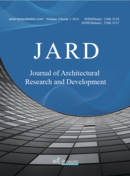How do We Remember Traumatic Events such as Massacre Through Architecture?
Abstract
Architecture is becoming an extraordinary method to save memories. This paper aims to show the relationship between traumatic events and architecture. This paper indicates that the positive side of memorial architecture from traumatic incidents on strengthening national identity, cultivate patriotism in the educational field, and becoming the city’s icon. It also presents the building architecture drawbacks on emotion and mentality of people and occupies much city’s area. Indeed, giving depth research on typical cases to analyse the influence for people. The findings clearly show that building is common use in remembering traumatic events.
References
Barry K, 2017, Buildings as Artifacts: Heritage, Patriotism, and the Constructed Landscape, 5(1): 3. Available at: http://doi.org/10.5334/ah.189.
Bathrick D, Prager B, Richardson MD, 2008, Visualizing the Holocaust: Documents, Aesthetics, Memory. Rochester, Camden House, New York.
Bennett T, 1995, The Birth of the Museum. History, Theory, Politics. London, Routledge.
Cuny FC, 1999, Fred C. Cuny Memorial Continuing Education Series Principles of Disaster Management Lesson 5: Program Supervision, Monitoring, and Control. Prehospital and Disaster Medicine, 14(3): 91–103.
Dong WR, 2016, Space Organization Model of Memorial Buildings for Major Events: A Case Study of the Nanjing Massacre Memorial Hall. Doors & Windows, 11.
Feldman A, 2004, Memory Theatres, Virtual Witnessing, and the Trauma-Aesthetic, Biography, 27: 1165.
Fetzner MG, et al., 2011, What is the Association between Traumatic Life Events and Alcohol Abuse/Dependence in People With and Without PTSD? Findings from a Nationally Representative Sample. Depression and Anxiety, 28(8): 632–638.
Guth CME, 1996, Japan 1868-1945: Art, Architecture, and National Identity. Art Journal, 55(3): 16.
He JT, Ni Y, Liu YB, 2015. Expansion of Memorial Hall for the Victims of the Nanjing Massacre by Japanese Invaders. Urban Environmental Design, 10: 62–67.
Jones PR, 2003, National Identity and Architecture.
Kraftl P, Adey P, 2008, Architecture/Affect/Inhabitation: Geographies of Being-In Buildings, Annals of the Association of American Geographers, 98(1): 213-231.
Lazarova J, 2017, Making Symbolic Architecture Matte.
Lemkin R, 1947, Genocide as a Crime under International Law. American Journal of International Law, 41(1): 145-151.
Liu LW, 2016, New West. On the Social Education Responsibility of the Memorial to the Youth, 36.
Nathaniel P, 2019, Does the History of Museum Education Begin?, Journal of Museum Education, 44(4): 337–341.
Niu LZ, 2013, Landmark Building as a Medium., 8: 131–132.
Pavlakoviæ V, Perak B, 2017, The Twentieth Century in European Memory: Transcultural Mediation and Reception. Boston: Brill Press.
Qi K, 1986, The Key to Conception: Remember the Creation of the Nanjing Holocaust Memorial Plan. New Architecture, 2.
Qi K, 1999, The Memorial Hall of the Victims in Nanjing Massacre by Japanese Invaders. Liaoning: Liaoning Science and Technology Press.
Sabine M, 2006, Visualizing Memories: The Hector Pieterson Memorial in Soweto, Visual Anthropology, 19(2): 145-169. Available at: 10.1080/08949460600598695.
Souto A, 2011, Archiving Berlin’s Past and Renewing the Ruhr Valley. Austausch.
Sternberg RJ, 1999. Stages of Memory.
Vale LJ, 1992, Architecture, Power and National Identity. London, Yale University.
Waterton E, Dittmer J, 2014, The Museum as Assemblage: Bringing Forth Affect at the Australian War Memorial, Museum Management and Curatorship, 29(2): 122-139.
Xie F, 2018, Analysis of the Public Space Sculpture Layout of the Nanjing Massacre Memorial Hall. Shanxi Architecture., 44(5): 12.

